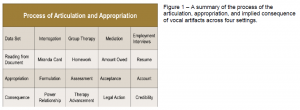Emily Warren and Dr. LeBaron Curtis, Department of Organizational Leadership and Strategy
The goal of this project was to examine how material objects and texts (e.g., resumes, letters, application files, etc.) may be appropriated and articulated during employment interviews. While past research focused on the verbal and discursive features of employment interviews, using research methods such as content analysis, discourse analysis, and conversation analysis, this was a multimodal study that highlighted the pervasive but taken-for-granted material and embodied aspects of employment interviews that have been largely overlooked. Our research findings have contributed to the growing awareness and understanding of socio-materiality in organizations and organizational routines. This research was presented as the National Conference of Undergraduate Research in 2012.
This research project included three stages: data collection, data analysis, and research presentation. After obtaining IRB approval, we collected video recordings of employment interviews a variety of other settings for contrast. This corpus of data was then analyzed in weekly “data sessions” with Dr. LeBaron and Dr. Glenn. I transcribed promising moments that we identified in these sessions, allowing us to jointly examine and discuss patterns of interaction in greater depth. Through this analysis, we uncovered a number of interesting occurrences.
Across the various recorded situations, a similar process began to emerge. In many instances, the artifacts were put into play in three stages: articulation, appropriation, and consequence. In one instance from the employment interviews, the document, a resume, was brought into play initially as the interviewer read a portion of it aloud. The resume was then appropriated as the interviewer called on the applicant to account for discrepancies between information contained on the resume and the applicant’s verbal statements. The consequence, in this instance, was the degree to which the applicant was deemed credible by the interviewer, which would have an impact on whether or not the applicant was selected for the position. While this may seem to be a minor consequence in this situation, the appropriation and articulation of artifacts in other scenarios resulted in consequences such as the power relationship in a police interrogation, therapy advancement for recovering convicts, and legal action in mediation.
This process of articulation, appropriation, and consequence naturally led to a discussion of the tactical advantages of reading from a document. While normal human conversation has a plethora of turn taking rules that are broken and followed in strategic and often unconscious ways, reading from a document suspends these typical turn taking rules. When a document is being read from, the person doing the reading often “has the floor” until the end of the document has been reached. In this sense, the artifact can be used to extend, almost indefinitely, the turn of one individual in an interaction, clearly tipping the power scales. Additionally, an artifact is difficult to argue with. A voice read from a document is ontologically both present and not: their voice is heard and information is shared, but they are not present to interpret, rescind, or explain.
Through the inductive process of data analysis, conclusions were reached as to the possible implications of situations involving vocal artifacts. In short, because of the change of rules granted to artifacts, these situations can be difficult to manage. The presence and use of an artifact clearly impacts the consequence of a situation, and as such someone’s ability to navigate an activity that involves “artifactual voices” can have real consequences. In a situation where one individual is aware of this and another is not, the implications for the novice can be particularly important.
This research was presented at the 2012 National Conference for Undergraduate Research as an oral presentation with a PowerPoint. The research in progress was also presented in a brief poster session for Brigham Young University’s President’s Leadership Council meeting. Both opportunities allowed the research to be shared with the scientific community to further understandings into the nature and consequences of using vocal artifacts.
References
- Glenn, P., & LeBaron, C. (2011). “Epistemic authority in employment interviews: Glancing, pointing, touching. Discourse & Communication.
- LeBaron, C. (2005). Considering the social and material surround: Toward microethnographic understandings of nonverbal behavior. In V. Manusov (Ed.), The Sourcebook of Nonverbal Measures (pp. 493-506). Mahwah, NJ: Erlbaum.
- Leo R.A. (1996). Miranda’s revenge: police interrogation as a confidence game. Law & Society Review, 30(2)
- Streeck, J., Goodwin, C., & LeBaron, C. (Eds.) (2011). Embodied interaction: Language and body in the material world. Cambridge, England: Cambridge University Press.
- Orlikowski, W. J. (2010). The sociomateriality of organizational life: considering technology in management research. Cambridge Journal of Economics, 34, 125–141.

